Aerial Derby - 1919
-
-Aerial Derby - 1919
THE VICTORY AERIAL DERBY
FOR THE
DAILY MAIL GOLD TROPHY (value 200 guineas) and the SHELL PRIZE of £500, for the winner, and
a SHELL TROPHY and £100 for the second man.
a SHELL TROPHY and £100 for first in the Sealed Handicap;
a SHELL TROPHY and £50 for the second man in the Handicap, and
a SHELL TROPHY and £25 for the third man in the Handicap

Saturday 21st June 1919. Start and Finish: Hendon
Weather: Rain threatened, then it turned out fine, but with a gusty wind.
Instructions:
1 Hendon Start and Finish - (pass over on first circuit).
The finishing line is in front of the Aerodrome Enclosures
2 Kempton Park Turning Point is the Waterworks Chimney. A square chimney, 230ft high, just north of Kempton Railway Station, very dark brown brick, with low building, filter beds and connecting reservoir. In the neighbourhood is a lower chimney (round), with two very large reservoirs. 3 Epsom Turning Point is the Race Course Grand Stand which is at the top of Epsom Downs, making a conspicuous land-mark. 4 West Thurrock Turning Point is at the Wouldham Cement Works, on north bank of the River near top of the bend a mile east of Purfleet and slightly to the east of West Thurrock Church. The actual point consists of a long rectangular buff-coloured building with a large diagonal white cross on the roof. Five factory chimneys stand in line at equal distances behind the building flanked by two taller chimneys and a high one further to the right. 5 Epping Turning Point is Epping Church Tower in centre of Epping Village on the West side of London Road, 200 yards south of Church is a solitary water tower 120 feet high. 6 Hertford Turning Point is a large white cross in Hartham Meadow immediately north of the town adjoining the railway stations and enclosed on the north, east and west by streams. 2 laps of 94.5 miles miles. Start: 3.30pm
See the newsreel (including the demonstration parachute jump, and Grahame-White himself leading the cheers):

Story of the Race:
"An immense success... one of the most interesting aerial events, from the technical point of view, ever held in this country"
Queen Alexandra was there to present the prizes, with Claude Grahame-White.

Mr Clifford B Prodger B.A.T. FK.23 Bantam G-EACN 1 retired lap 1 - down at Fairlop 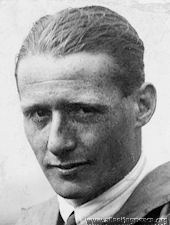
Capt P RT Chamberlayne Grahame-White GWE6 Bantam G-EAFK 2 retired lap 2 down at Epsom 
Maj Christopher Draper B.A.T. FK.23 Bantam G-EACP 3 4th/2nd 
Lt-Col George LP Henderson Avro 504K G-EAEV 4 6th/7th 
Maj Reginald H Carr Grahame-White GWE6 Bantam G-EAFL 5 retired Lap 1 - forced landing at Hounslow (engine trouble) 
Capt Gerald Gathergood Airco DH.4R G-EAEW 7 1st/5th 
Mr Marcus D Manton Airco DH.4 G-EAEX 8 2nd/4th 
Capt Howard JT Saint Airco DH.9 G-EAAC 9 5th/6th 
Lieut Robert Nisbet Martinsdyde F.4 G-EAES 10 2nd/3rd 
Maj Leslie R Tait-Cox Nieuport Nighthawk LC.1 G-EAEQ 11 retired lap 2 - down at West Thurrock (punctured carburrettor float) 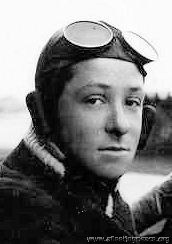
Mr Charles HC Smith Bristol Type 20 M.1C G-EAER 12 retired lap 1 - down at Hendon 
Capt H A Hamersley Avro 534 Baby G-EACQ 14 7th/1st
Starters: 12 (of 16 entrants) Finishers: 7
Did not start:
Pilot Aircraft Race No Lieut C Turner B.A.T. Commercial (5-seater) 15 Capt C R Vaughn B.A.T. Bantam 16 H G Hawker Sopwith 17 Capt J Alcock Vickers 18 -
-The Aviators
The Aviators
-
Carr, Reginald Hugh
Maj Reginald Hugh Carr DSM, AFC

photo: 1913, aged 26
b. 9 September 1886 in Walthamstow, Essex, an 'Aeroplane Engineer'.
Won the the Michelin Cup in 1913 for the year's longest flight (315 miles), and competed in the 1914 Aerial Derby (coming 2nd); the 1914 London-Manchester Race (also 2nd), and the 1914 London-Paris Race.
19 Squadron in WWI, then a test pilot for Grahame-White.
d. 1968.
-
Chamberlayne, Paul Richard Tankerville James Michael Isidore Camille
Capt Paul Richard Tankerville James Michael Isidore Camille Chamberlayne AFC

known as 'Tanks' (rather than Paul Richard Tankerville James Michael Isidore Camille).
b 15 May 1895 in Larnaca, Cyprus, of an Austrian family; educated at Eton, then a Captain in the 11th Hussars in WWI who transferred to the RFC in 1915. He then went to Canada in 1918, and was Chief Flying Instructor at the Toronto 'School of 'Special Flying' for a year.
Whilst racing at Hendon in July 1919, a couple of weeks after the Aerial Derby, Capt Chamberlayne had a "miraculous escape... [he] is to be congratulated on still being alive. He lost control of the machine and flew straight into one of the iron supports of a hangar. Fortunately the machine remained 'stuck' where it had hit, and he managed to extricate himself almost unhurt, although soaked with petrol."
He had already won the race, btw, and was just showing off.
Later, Chief Pilot of the Grahame-White School of Flying, then rejoined the RAF (India in 1920, Andover in 1927, Sqn-Ldr in Iraq 1932-35, Assistant Air Attache in Paris 1937 then Lisbon in 1938).
Wing Commander from 1938; Air Commodore in 1943.
When war was declared in Europe in 1939, he became desperate to return to Britain to see action and apparently "tried to upset the German Embassy by getting drunk and singing 'Rule Britannia' under their windows."
d. 3 May 1972
-
Draper, Christopher
Maj Christopher Draper DSC, Croix de Guerre 
photo: 1913, aged 21
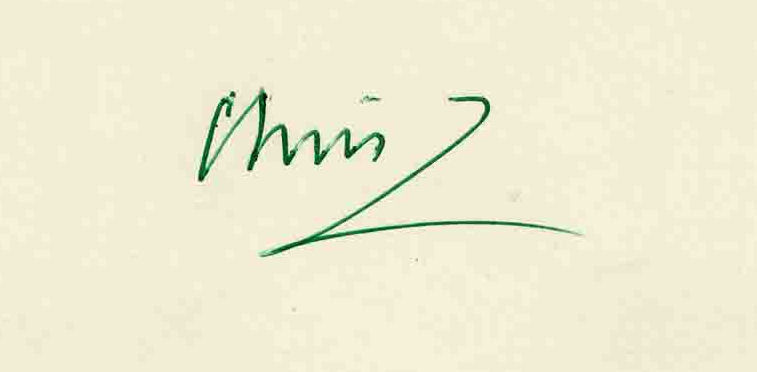
b. 15 Apr 1892 in Bebington, Cheshire
WWI pilot known as the 'Mad Major'; he once challenged a colleague to an aerial duel... with real bullets...
In 1919, "Major Draper's flying on the B.A.T. Bantam is easily one of the greatest attractions of the show... it can truly be described as thrilling"; the following April, he was reported to be progressing well after his recent serious accident, his fractured ankle being in "splendid position".
Ten years later in September 1931, however, he was caught up in a strange little incident. Having not flown for many years, jobless and absolutely broke, he borrowed £5, hired an aeroplane and flew it twice under Tower Bridge and once under Westminster Bridge. He did this, he said, "to prove that he was still the highly qualified specialist that he used to be". The alderman in charge of the case said he had been intending to fine him £100, but bound him over rather than send him to jail for non-payment; "I am surprised that a man with such qualifications should find it so difficult to get a job".
Actually, the ruse worked and led to him becoming an actor and stunt pilot in several films in the 30s.
Then things got even more curious when his constant criticism of Britain's treatment of its war veterans came to the attention of the Nazi Party, and he was asked to spy for the Germans. He agreed, but also mentioned it to MI6, and spent four years as a double agent until the Germans obviously worked out what was going on and stopped answering his calls.
The pattern repeated itself after WWII - in May 1953, aged 61, having drifted into and out of a number of jobs, he hired an Auster and this time flew under 15 of London's 18 bridges, "for the publicity".

He escaped with a fine this time as well.
The Mad Major published his autobiography in 1962, and died in 1979 in London aged 86.
-
Gathergood, Gerald William
Capt Gerald William Gathergood  1916, aged 21, when a Lieut in the 16th Durham Light Infantry
1916, aged 21, when a Lieut in the 16th Durham Light Infantryb. 15 June 1895 in Tilney St Lawrence, Norfolk
WWI pilot. His flying was described thus: "he always threw all machines about the sky in a most alarming manner".
Became a dental surgeon, married Peggy Thompson in 1930, played golf and...
d. 21 May 1966 aged 70
-
Hamersley, Harold Alan
Capt Harold Alan Hamersley MC  1920
1920b 6 Feb 1896 in Guildford, W Australia.
Studied mechanical engineering before WWI, commonwealth commission then transferred to the RFC in June 1916. Served with 60 Sqn in France, where he was awarded the MC for gallantry in leading patrols. Ended the war with 11 victories, despite his SE.5 being damaged and forced down by German ace Werner Voss in September 1917.
Awarded a permanent RAF commission in 1926, then promoted to Wing Commander in 1938 as Chief Instructor to the London University Air Squadron.
d. 1967
-
Hawker, Harry George
Mr Harry George Hawker MBE, AFC 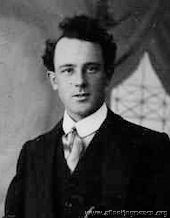
in 1912, aged 23
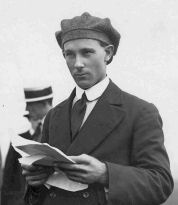
b. 22 Jan 1889 in Victoria, Australia; son of a blacksmith, and the co-founder of Hawker Aircraft.
A very early flier - RAeC Certificate No 297, in 1912. The following year, he made 5 flights 'on and off water' in a Sopwith-designed seaplane, which meant that they won the £500 offered by the RAeC.
An even bigger prize in 1913 was the £5,000 offered by the Daily Mail for a race for seaplanes, to cover nearly 1600 miles in 72 hours round the coast of Britain. Harry (with fellow Australian H Kauper as mechanic) started off in a Sopwith from Southampton on August 16th. They got as far as Yarmouth but Harry felt unwell (later they worked out that he had sunstroke) and had to return to Southampton for another try, which started on the 26th.
Unfortunately, having made good progress on their first day, nearing Dublin on the second his foot slipped off the rudder bar, the aeroplane fell "like a stone" and dumped them in the Irish Sea, whence they had to be rescued by the Coastguard; the machine was wrecked. Harry was unhurt, Mr Kauper injured. The Daily Mail gave them a consolation prize of £1,000 "in recognition of their plucky attempt".
A few weeks later, he wrote off another Sopwith at Brooklands, badly injuring his back. The following year he did it again in almost the same place, this time failing to control a loop and spinning down into some trees. When spectators reached the scene, Harry was standing by the smashed aeroplane, "bewildered but unhurt".
Nothing daunted, he broke the British altitude record by climbing to 18,393ft in 1915, although it took him over an hour and he" suffered greatly from the cold"; he then broke the world record by getting to 24,408ft on 26 April 1916 (which started people wondering about perhaps flying to the top of Everest).
Next, in 1919, the Daily Mail offered £10,000 for a flight across the Atlantic. Harry, with Commander Kenneth Mackenzie Grieve R.N. as navigator, started from Newfoundland on 18th May but the aeroplane had problems with its radiator and they had to put down in the sea after about 800 miles. It was several days before the news emerged that they had been rescued by the small steamer 'Mary', and taken to Thurso. The Nation, having feared the worst, was mightily relieved, and gave them a terrific welcome; "No event since the Armistice has so stirred the popular imagination". Harry and Kenneth got the Air Froce Cross each (despite the fact that Harry wasn't actually in the Air Force), and £2,500 each as a not-inconsiderable consolation prize (although they had agreed to split the original prize 70:30). Before they could try again (on June 15th to be precise), Alcock and Brown had done it (just), been knighted by Mr Churchill and walked off with the cheque for £10k. Damn!
His luck finally ran out when he was killed in the Nieuport Goshawk G-EASK which crashed at Hendon 12 July 1921 while he was preparing for that year's Aerial Derby. The aeroplane burst into flames and spun in; Harry leapt from (or fell out of) the plane and was found some distance from its remains, "quite dead".
-
Henderson, George Lockhart Piercey
Lt-Col George Lockhart Piercey Henderson  1920, aged 32
1920, aged 32b. 15 Apr 1888 in Simla, India, a 'law student' in 1915
RFC in WWI; commanded 66 Squadron in 1917.
In 1919, he offered flights to the general public in an Avro at Hounslow Aerodrome: £1 a head. There was enormous interest; queues of 50 or more were patiently waiting and the aeroplane could hardly get up and down fast enough. Consequently, he was described as the 'best-known of the competitors' in that year's Aerial Derby.
He and a Lieut Herrstrom then opened a flying school in Sweden - "ideal conditions for winter flying", they said.
Later, President of the Federation of Pilots; in 1924, he and Frank Barnard were in talks with Lord Thompson about the dispute over terms and conditions for the pilots of the newly-formed Imperial Airways.
He was still competing in 1927, coming third in the Poole Handicap for owner-pilots.
He got some flak in 1928 when he opened a service from Cape Town and Johannesburg using Junkers tri-motor aeroplanes but, as he pointed out, it was the cheapest option.
He was killed 21 July 1930 in Junkers F.13ge G-AAZK belonging to the Walcot Air Line, which crashed near Gravesend, Kent. His co-pilot and the four passengers also died. The inquiry concluded that the aeroplane had broken up in flight due to 'buffetting', but Junkers produced convincing evidence of pilot error, suggesting that he pulled out of an inadvertent dive too violently.
His ashes were scattered from an aeroplane over Croydon.
His book 'A Complete Course of Practical Flying' was published almost the same day.
-
Manton, Marcus Dyce
Mr Marcus Dyce Manton  1912, aged 19
1912, aged 19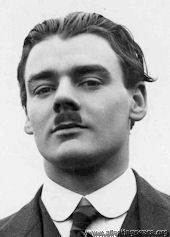
b. 14 Sep 1893 in Sheffield, an 'Engineer's Improver' in 1912, later an instructor at Hendon for Grahame-White - he applied for the RFC but was rejected on medical grounds.
After WWI he was a test pilot for Samuel White and English Electric; he also became interested in gliding and became a member of the London Gliding Club and a founder-member of the British Gliding Association. In WWII he was with Armstrong Whitworth as Service Liaison Officer.
And he was remembered for wearing "startling socks".
d. May 1968 in Bridport, Dorset
-
Nisbet, Robert H
Lieut Robert H Nisbet  1920, aged 33
1920, aged 33b. 16 Oct 1887 in Fife, N.B.
Resigned his commission in Jan 1924, took out some patents when working for Sperry Instruments in 1939, and
d. before 1951
-
Prodger, Clifford Beaumont
Mr Clifford Beaumont Prodger 

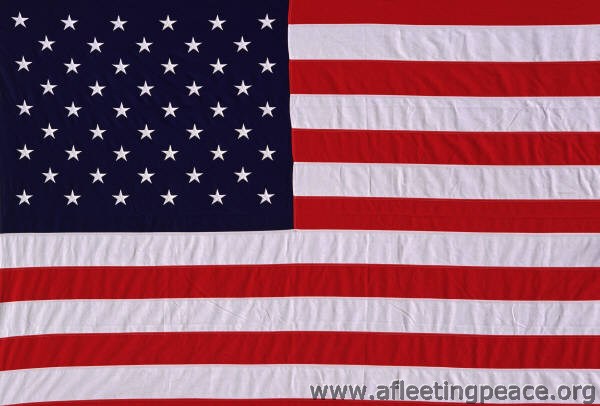 b. 8 June 1889 in Alexandria, Minnesota, USA
b. 8 June 1889 in Alexandria, Minnesota, USAFlight said in 1917 :"I always thought that Walter L. Brock, the unceasing masticator and the winner of many notable aerial races, was the most modest American England had ever seen, until C. B. Prodger came over."
After seven years as a rancher in the Little Missouri Valley, he worked for the Northern Pacific Railway, then went into the motor business and became well known as an amateur racer. He won many prizes, including the Montana Speed Trophy in 1910.
Learnt to fly in 1911 with Beatty in the USA, then did a good deal of special work for the Pathe Film Co. and also went in for night flying. In the spring of 1913 he went to Montana to give exhibitions on his own machine—a monoplane with an 8-cylinder V-type Boland motor.
After this it seemed, he said, that there was "nothing doing" in aviation in the USA, and he gave up flying for a time. Then in February, 1915, he came over to Hendon and rejoined Beatty to assist him in training pilots for the R.N.A.S.
When the school closed down, he took over from Sydney Pickles as an official test pilot, assessing every kind of aeroplane, "his calm, analytical mind being admirably adapted for work of this nature."
Killed 22 Aug 1920 in Redwood City, California, with two other aviators, in a crash from a height of 300 feet.
-
Saint, Howard John Thomas
Capt Howard John Thomas Saint 
photo: 1915, aged 22, when a Flt Sub-Lt in the RNAS
b. 23 Jan 1893 in Ruabon, N Wales
RNAS in WWI (June 1916).
Joined the Aircraft Manufacturing Company after WWI, and was the first pilot then licensed by the Air Ministry.
He conducted the very first flight after the ban on civilian flying was raised on May 1, 1919, taking off from Hounslow before dawn in a D.H.9, with a parcel of Daily Mails, heading for Bournemouth. Unfortunately, "fog was encountered in the neighbourhood of Portsmouth, and a forced landing on the Portsdown Hills resulted in the machine being wrecked and the pilot, Capt. H. J. Saint, D.S.C., and passenger, Capt. D. Greig, being injured."
Rejoined the RAF in March 1922, and (as F/O Saint) competed in a handicap race at the RAF Pageant later that year.
In 1927, he became chief test pilot for Gloster. He had a narrow escape in 1933; "The Breda monoplane on which has been fitted the Ugo Antoni variable-camber wing crashed on Chosen Hill, Churchdown, near Gloucester, on Friday last. Mr. H. J. Saint, Gloster's chief test pilot, had taken the machine up in very bumpy weather, and a couple of minutes afterwards wing flutter developed, a portion of the port aileron came adrift and the machine sideslipped into some trees, Mr. Saint escaping with minor injuries."
Married twice, September 1918 (divorced August 1934) and in 1936.
Retired to Cheltenham, Gloucestershire and died there in Sept 1976.
-
Smith, Charles Henry Chichester
Mr Charles Henry Chichester Smith 
Photo: 1914, aged 17
b. 22 Feb 1897 in Boston, USA
-
Tait-Cox, Leslie Robert
Maj Leslie Robert Tait-Cox  1916, aged 19
1916, aged 19 1920
1920b. 27 April 1897 in London
RFC and RAF in WWI, then an "exceptional" test pilot for Nieuport and General Aircraft Co Ltd, of Cricklewood.
Elected a Member of the RAeC in October 1921; at the time, the firm of 'Tait-Cox and James, Test Pilots' were extremely busy, and "could find work for half-a-dozen pilots", if they could find them.
In fact Leslie, followed by Jimmie, broke the British Speed record in 1921.
Joined Major Jack Savage's 'Sky-writers' in 1922 - as did Mogens L Bramson, Cyril Turner, G A Lingham, G F Bradley, D A Shepperson, C R McMullin, E D C Herne, Sydney St Barbe, Charles Collyer (US), Marttin Rudolph (Germany), and W von Feilitzsch (Germany).
Rejoined the RAF in 1926, and left in Jan 1935, to become a "Technical Mechanical Engineering Liason Officer"
Joined Plessey after WWII and d. Oct 1959 - Maidenhead, Berks.

